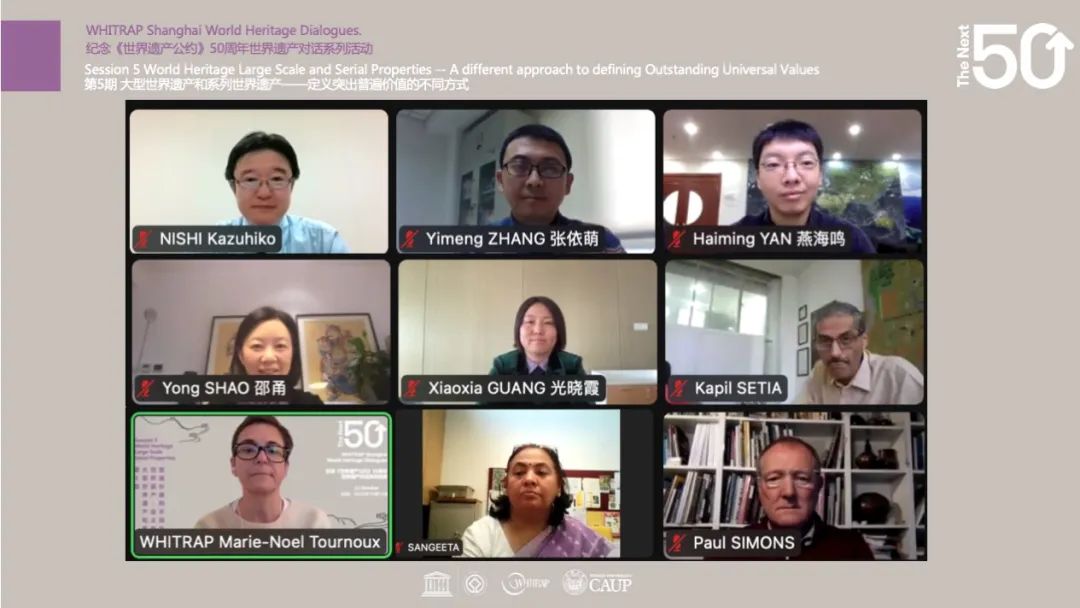
The 5th WHITRAP Shanghai World Heritage Dialogue was held on 12 October 2022. It focused on World Heritage Large Scale and Serial Properties-- A different approach to defining Outstanding Universal Values.
For the video of the activity, please click the link below:
http://heritap.whitr-ap.org/index.php?classid=12497&id=42&t=show
01 Background
The 6 monthly online thematic Dialogues series are organized and hosted by WHITRAP Shanghai and College of Architecture and Urban Planning (CAUP), Tongji University, and their outcomes will be presented and further discussed and presented on 15-16 November in an international conference on "World Heritage and Urban-Rural Sustainable Development: Resilience and Innovation based on Humanity " also organized by WHITRAP and CAUP Tongji University.
The 5th Dialogue was devised and chaired and moderated by Marie-Noël TOURNOUX, Project Director of WHITRAP Shanghai and the Rapporteur was Prof. SHAO Yong, Professor at College of Architecture and Urban Planning, Tongji University, China.
Seven experts from the Asia and Pacific Region and the United Kingdom were invited to share their views on the topic of World Heritage Large Scale and Serial Properties -- A different approach to defining Outstanding Universal Values.
• YAN Haiming, Associate Research Fellow at China Academy of Cultural Heritage, Director of ICOMOS China Secretariat
• NISHI Kazuhiko, Chief Senior Specialist for Cultural Properties Office for International Cooperation on Cultural Heritages Agency for Cultural Affairs, Government of Japan
• Dr Sangeeta BAGGA, Principal, Chandigarh College of Architecture, Chandigarh, India
• Kapil SETIA, Chief Architect, Department of Urban Planning Chandigarh in the Chandigarh Administration
• GUANG Xiaoxia, Associate Research Curator on Cultural Relics and Museum of Yangzhou World Heritage Conservation and Management Office (Grand Canal Heritage Conservation and Management Office)
• ZHANG Yimeng, Associate Researcher, World Cultural Heritage Centre of China at the Chinese Academy of Cultural Heritage (CACH), China
• Paul SIMONS, Secretary General Great Spa Towns of Europe, United Kingdom
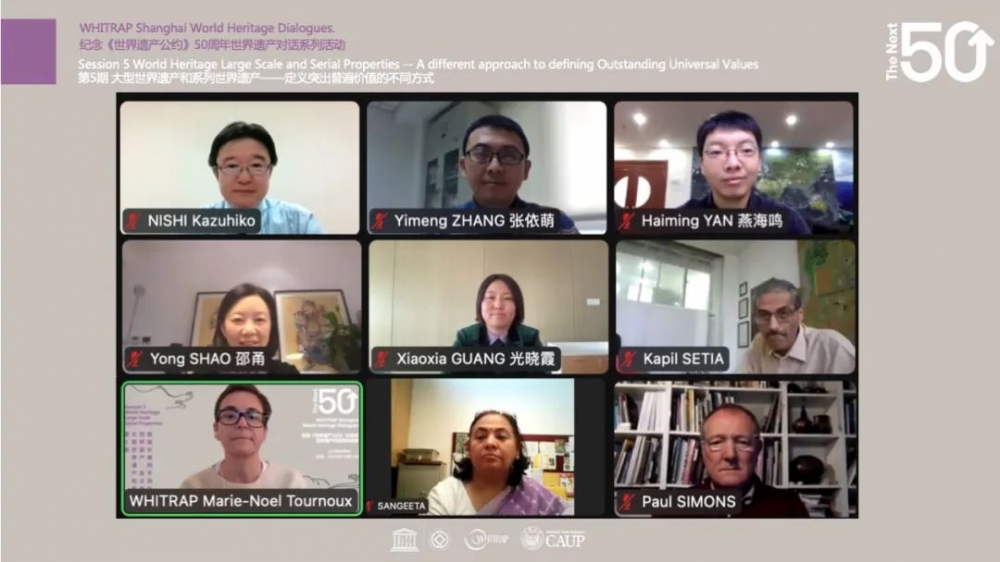
Group photo
02 Opening
After welcoming the participants and audience, the Chair, Marie-Noël TOURNOUX introduced the aims, participants, and agenda of the 5th Dialogue. She pointed out that the second half of the 20th century saw the evolution of a different approach to history focusing on long time spans, geo-cultural areas, complex social dimensions as well as the interaction between different areas of knowledge, which lead to considering different types of objects, their functional relation in time and space. She introduced that the panellists would share their views on whether the classification of large, serial, or transnational properties (the way in which World Heritages are nominated) helped to define the outstanding universal values of different World Heritage sites and analyse the opportunities and challenges in the conservation and management of large, serial or transnational properties.
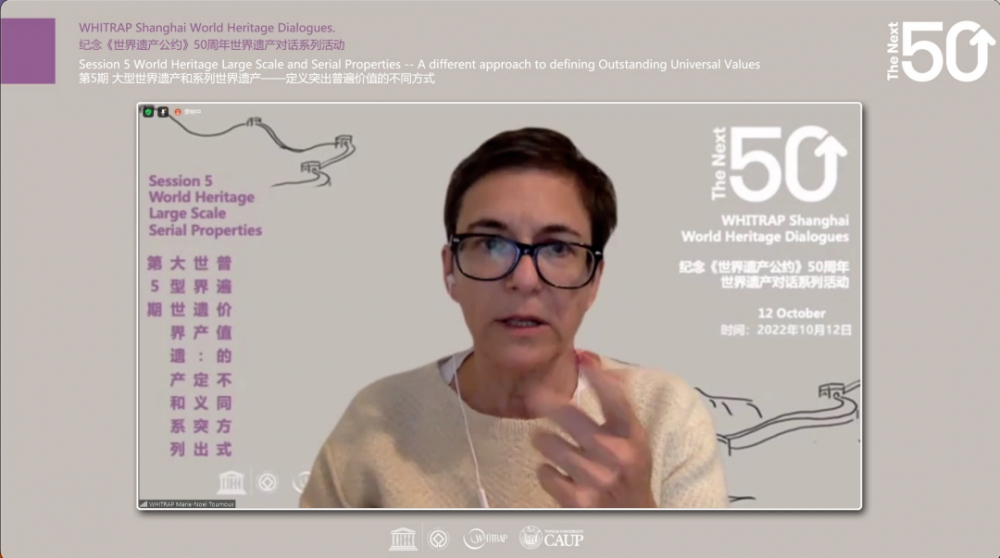
03 Introduction
YAN Haiming presented the category, concepts and challenges of large-scale and serial heritage. He pointed out four types, serial property, transboundary property, cultural routes, and large heritage sites. He cited the examples of Korea's Seowon and China's natural and cultural mixed heritage Taishan to explain serial heritage. He continued by explaining what where trans boundary and transnational properties were and then how serial heritage could be further divided into heritage on the territory of a single State Party and within the territory of different States Parties, giving examples of the Great Wall and the Roman Limes sites. He introduced the complexity of cultural routes with the examples of France and Spain and the Silk Road. He pointed out that large-scale heritage faced greater difficulties in conservation and management, high development pressures, and a lack of interpretation systems.

YAN highlighted how the new concept was definitely going to present new solutions and new ideas for better management and better coordination. Large-scale heritage represented not only a legacy of human history but also an expression of wisdom and techniques based on the setting of sites. He continued by highlighting how we are constantly refreshing our understanding of the world and heritage values and the role of Academia regarding research. He pointed out how serial heritage needed better coordination mechanisms for the management level, to involve more stakeholders.
04 Pecha Kucha
NISHI Kazuhiko focused on the trans-continental nomination, conservation, and promoting awareness of modern heritage. He listed the specific process of Le Corbusier's architectural nomination and explained the role of OUV in the nomination process. He concluded by pointing out the nomination had a positive effect on the understanding of the Modern Movement.
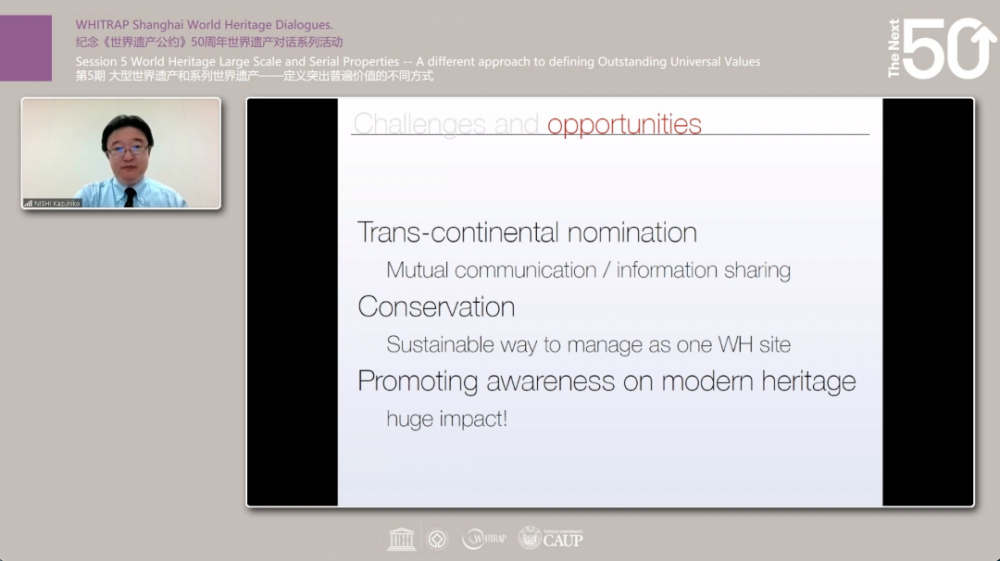
GUANG Xiaoxia explained the coordination of cultural heritage protection, using the Grand Canal as an example.

ZHANG Yimeng focused on the challenge of maintaining the integrity of the Great Wall's OUV, through better understanding and documenting the property. He highlighted the importance of going beyond understanding the Great wall as a building or monument and considering its wider setting and also its intangible symbolic significance, as well as the authenticity of the Great Wall.
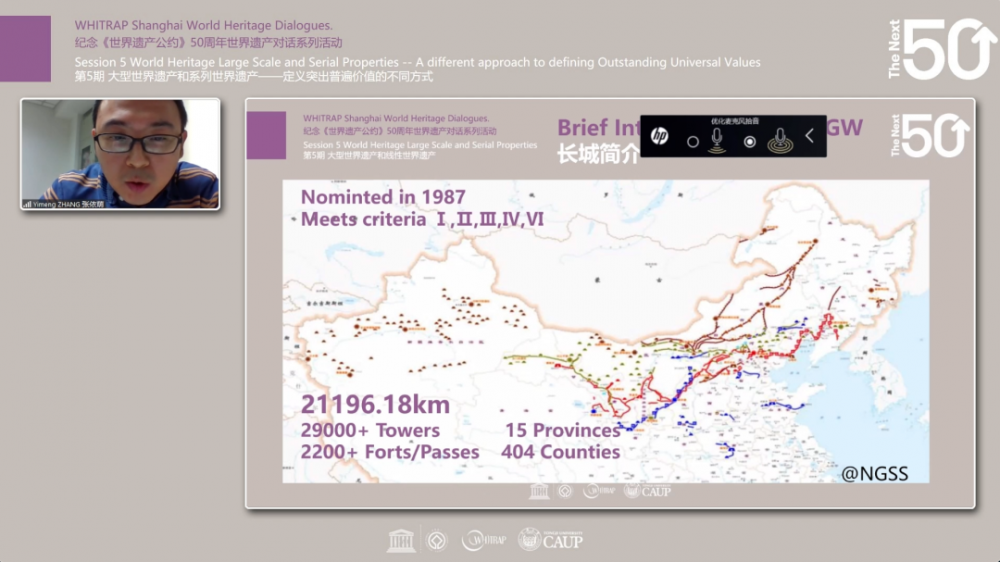
Paul SIMONS described the significance of the spa towns as a major European phenomenon and a unique contribution to cultural life and how it needs to be proclaimed and emphasised in particular to European decision-makers and institutions. He also explained how the value of spa towns lay in the physical fabric as well as in their intangible features.
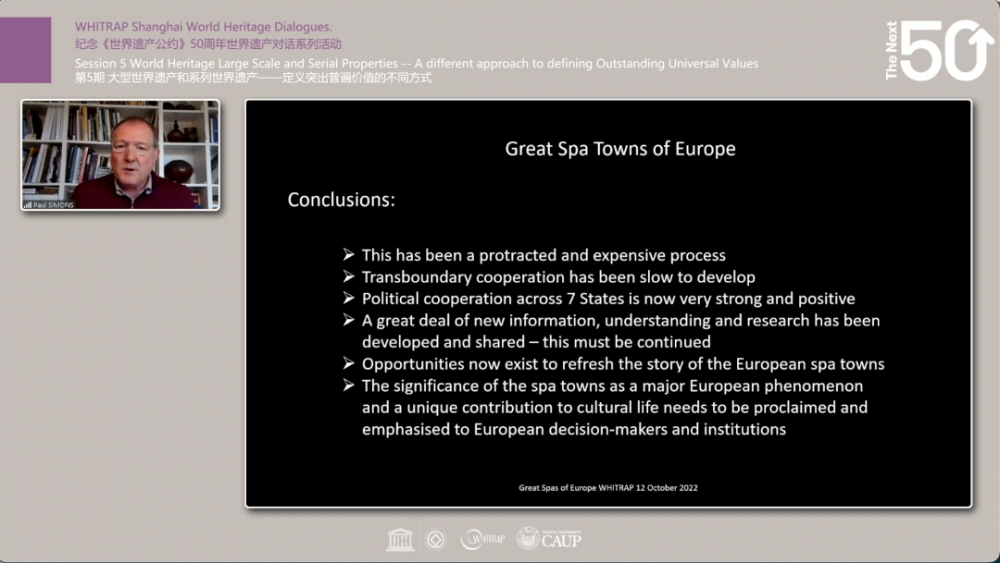
Dr Sangeeta BAGGA, Principal, Chandigarh College of Architecture, Chandigarh, India. Sangeeta stressed the specificity of identifying values in serial nominations. She explained how each element contributes to a collective value and is not considered as a compilation of a single element. She further detailed the nomination process and described the challenges of safeguarding and managing the Capitol Complex of Chandigarh, the largest property of the series, which is a living site subjected to pressures of everyday use, hence the need for adequate development and management of the site and the necessary tools and framework to do so.
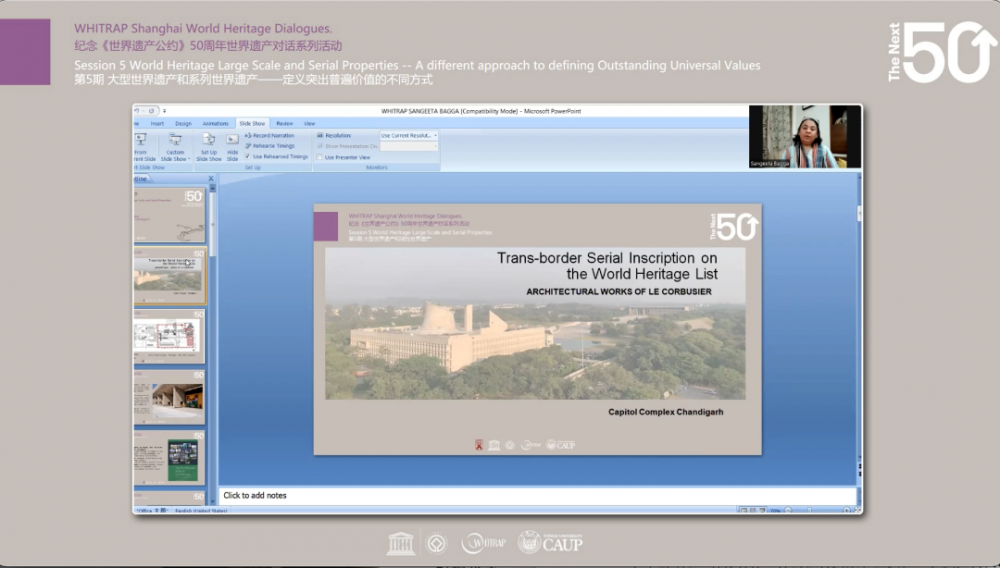
Kapil SETIA contributed to the round table. where he complimented Sangeeta BAGGA’s presentation. He focused on the challenges of keeping the balance between conservation and development pressures in a living site, which requires more facilities and more complex ways of adding functions to the infrastructure. He also highlighted the need for stakeholder consultation and engagement and its complexity for an inter-State City such as Chandigarh. Furthermore, he explained the other challenge was environmental pressure.
05 Round Table
The round table was moderated by Marie-Noël TOURNOUX. She invited discussants in turn and asked them to reflect on two questions:
1) In your opinion and based on your experience, does scale, a serial and or transnational approach help to define the Outstanding Universal Value differently? And if so how?
2) In your opinion and based on your experience, what are the two key conservation and management opportunities and challenges of large, serial and transnational properties?
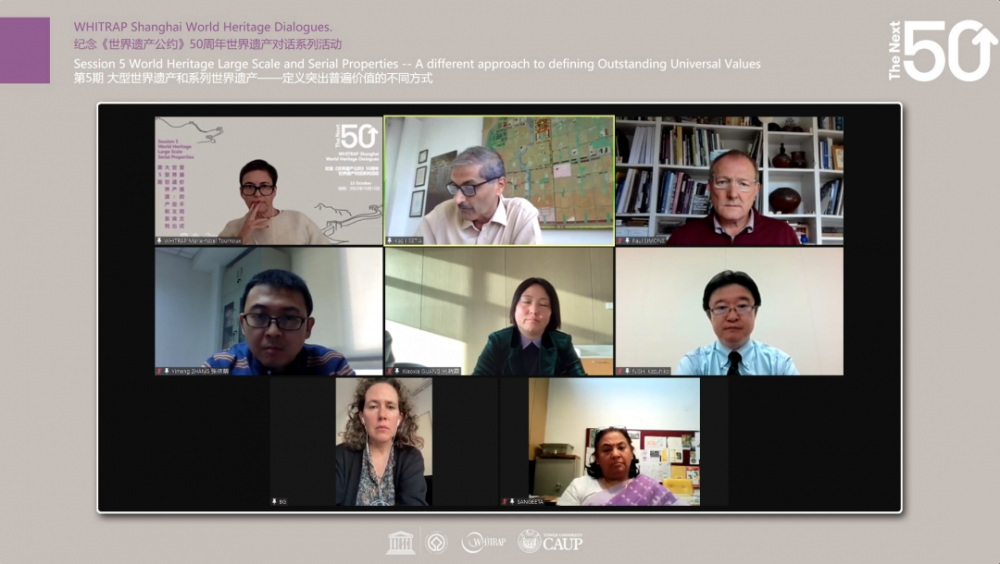
The round table started with Kapil SETIA, NISHI Kazuhiko, and Sangeeta BAGGA who discussed the Architectural Work of Le Corbusier, an Outstanding Contribution to the Modern Movement with a contribution from Bededicte GANDINI, who comes from the Le Corbusier Foundation and is the coordinator of the property. Followed by Guang Xiaoxia and Zhang Yimeng who shared their views on the Grand Canal and the Great Wall in China, Paul Simons presented the opportunities and challenges related to the Great Spa Towns of Europe.
Throughout the round table, the participants focused on defining OUV, its protection and its management.
1. Definition of OUV: participants stressed that the focus should be not on the most beautiful, but the most representative of cultural diversity and human civilization. More emphasis was placed on the stratification of history and the relevance of culture.
2. Protection of OUV: based on how to better identify and protect the value components of OUV, how to understand functions, and determine new functions and changes, modernization and new facilities compatible with the protection of the tangible attributes which carry the OUV in particular in the case of Modern Heritage and spa towns for example. The discussants reflected on the need for more technological innovations for improving knowledge of sites, such as in the case of the Great Wall or Grand Canal, monitoring needs, repairing and restoration techniques, etc.;
3. Management of OUV: The discussion allowed to highlight the challenges of building adequate integrated inclusive management systems, which would allow for coordination between all stakeholders and decision-makers, bodies in charge of monitoring sites, local people at all levels, local regional, national and transnational. Participants identified education about heritage and raising awareness as a key priority in particular for local authorities and technical administrations less aware and not specialized in heritage management for which capacity building needed to be developed. The issue of funding protection and management as well as developing different economic models was an area identified as needing more reflection and innovative approaches. Each discussant showcased different examples of innovative approaches, whether theoretical innovation or in the practice of protection. Amongst the challenges addressed, monitoring positive and negative impacts on heritage was equally pointed out as a priority to avoid conflicting development priorities. The discussion strongly advocated developing legal frameworks and operational tools to guarantee the enforcement of the law. Additionally, participants encouraged sharing information and developing integrated heritage-focused planning at a larger scale than the World Heritage properties. They also explained the need for the long-term commitment of decision-makers who were often in office for a short period.
06 Wrap Up
Prof. SHAO Yong recalled firstly the Chinese context and the protection since the 90s of serial heritages or the protection of large-scale heritage. Furthermore, she highlighted that in recent years, China had been carrying out a series of regional and cross-regional heritage protection measures and developing new protection legal instruments such as National Cultural Parks. In particular, China was now carrying out territorial space planning, which was a very important institutional reform.
Secondly, she identified a series of key points regarding how serial and or transnational approaches helped to define the Outstanding Universal Value differently and regarding. Key conservation and management opportunities and challenges of large, serial and transnational properties.
Throughout the round table, the participants stressed the need for stronger interconnections, as different aspects of heritage and the challenge of managing change.
The discussion stressed how the nomination process and the inscription of the properties had a ripple effect in raising awareness of heritage which related to the heritage values defined as OUV or in identifying complementary values which didn’t support the OUV but revealed the richness of the sites.
The Dialogue highlighted the role of people as beneficiaries and stakeholders in particular regarding, governance, knowledge development and dissemination of heritage values, as well as the importance of international cooperation, which was more important than ever.
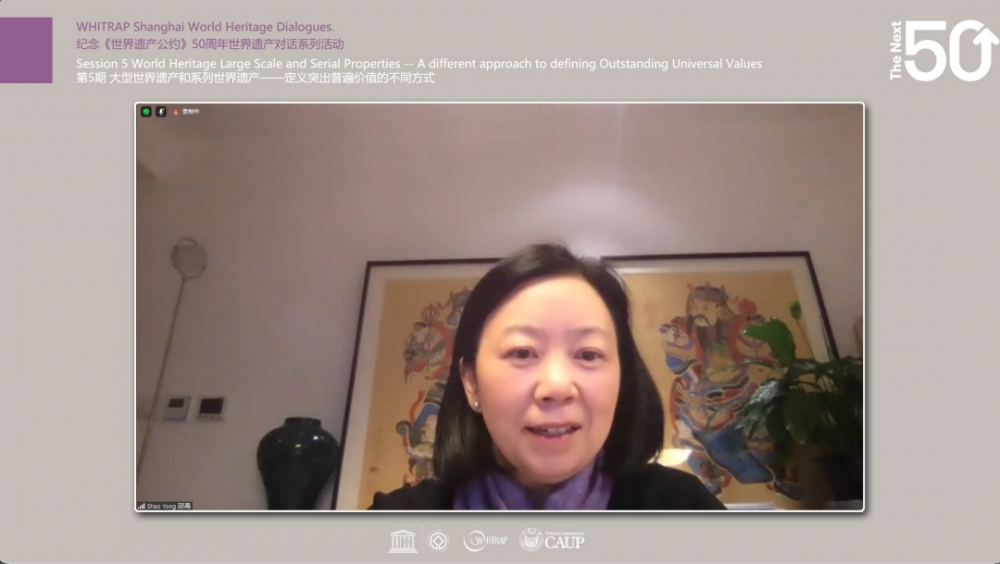
07 Closing
Marie-Noël TOURNOUX thanked Prof. Shao Yong for her comprehensive wrap-up and all the participants. She highlighted future cooperation and research areas on management, nomination processes and economic development. She announced the next Dialogue on World Heritage: Filling the Gap between Culture and Nature -- Rethinking the Contribution of “Connecting Culture and Nature” to the World Heritage Convention, on Wednesday 2 November.
